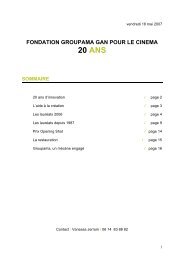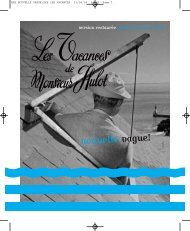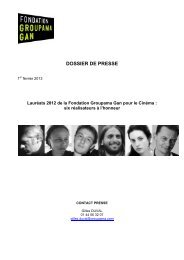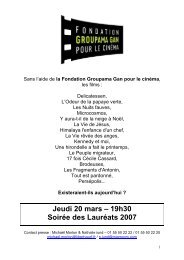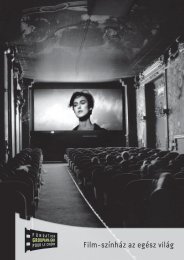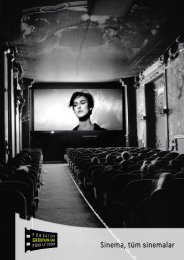Dossier de presse « Lola - Ciné-Tamaris
Dossier de presse « Lola - Ciné-Tamaris
Dossier de presse « Lola - Ciné-Tamaris
You also want an ePaper? Increase the reach of your titles
YUMPU automatically turns print PDFs into web optimized ePapers that Google loves.
anouk aimée<br />
Born in Paris, Anouk Aimée was spotted at the age of 13<br />
by Henri Calef, who selected her for his film La Maison<br />
Sous la Mer. She later played the role of Juliet alongsi<strong>de</strong><br />
Serge Reggiani in The Lovers of Verona by André Cayatte,<br />
based on a script by Jacques Prévert. After the success<br />
of this film, Anouk Aimée acted in many other feature<br />
films, including Richard Neame’s Gol<strong>de</strong>n Salaman<strong>de</strong>r<br />
(1950), Alexandre Astruc’s The Crimson Curtain (1951) and<br />
Bad Liaisons (1955), Julien Duvivier’s The House of Lovers,<br />
Jacques Becker’s Montparnasse 19 (1957); Jean-Pierre<br />
Mocky’s The Chasers (1958) or Georges Franju’s Head<br />
Against the Wall (1958).<br />
Frédérico Fellini directed her in 1960 in La Dolce Vita,<br />
which won the Palme d’Or at the Cannes Film Festival, she<br />
then shot <strong>Lola</strong>, Jacques Demy’s first film, a role that she<br />
would later pick up again in Mo<strong>de</strong>l Shop. She worked again<br />
with Fe<strong>de</strong>rico Fellini in 1962 with 81/2. After acting in The<br />
Last Judgement by Vittorio <strong>de</strong> Sica (1961), The Terrorist<br />
by Gianfranco <strong>de</strong> Bosio, A Very Handy Man by Alessandro<br />
Blasetti (1963), and The Escape by Paolo Spinosa (1964),<br />
she met Clau<strong>de</strong> Lelouch who directed her alongsi<strong>de</strong> Jean-<br />
Louis Trintignant in A Man and a Woman (1966).<br />
Her performance was awar<strong>de</strong>d a Gol<strong>de</strong>n Globe, a Bafta and<br />
an Oscar nomination for Best Actress.<br />
2011 Mince Alors! by Charlotte <strong>de</strong> Turckheim<br />
2010 Tous les Soleils by Philippe Clau<strong>de</strong>l<br />
2003 Happily Ever After by Yvan Attal<br />
the Birch-Tree Meadow<br />
by Marceline Loridan-Ivens<br />
2001 Festival in Cannes by Henry Jaglom<br />
1999 One 4 All by Clau<strong>de</strong> Lelouch<br />
Ma<strong>de</strong>leine by Laurent Bouhnik<br />
1996 Men, Women: A User’s Manual by Clau<strong>de</strong> Lelouch<br />
1994 Prêt-à-Porter by Robert Altman<br />
Dis-Moi Oui by Alexandre Arcady<br />
1993 The World of Jacques Demy by Agnès Varda<br />
the Groundhogs by Elie Chouraqui<br />
1986 A Man and a Woman: 20 years later<br />
by Clau<strong>de</strong> Lelouch<br />
1984 Long Live Life by Clau<strong>de</strong> Lelouch<br />
success is the Best Revenge<br />
by Jerry Skolimowski<br />
1983 The General of the Dead Army by Luciano Tovoli<br />
1982 What Makes David Run? by Elie Chouraqui<br />
1981 the Tragedy of a Ridiculous Man<br />
by Bernardo Bertolucci<br />
1980 A Leap in the Dark by Marco Bellochio<br />
1978 Due Volte Donna by Elie Chouraqui<br />
1976 second Chance by Clau<strong>de</strong> Lelouch<br />
1968 The Appointment by Sidney Lumet<br />
Mo<strong>de</strong>l Shop by Jacques Demy<br />
justine by George Cukor and Joseph Strick<br />
1967 uN Soir Un Train by André Delvaux<br />
1966 A Man and a Woman by Clau<strong>de</strong> Lelouch<br />
1965 seasons of Our Love by Florestano Vancini<br />
Anouk Aimée later featured in the films Un Soir, Un<br />
Train by André Delvaux, The Appointment by Sidney Lumet<br />
(1968), and Justine by George Cukor and Joseph Strik in<br />
1969. After a voluntary period of down time, she worked<br />
again with Clau<strong>de</strong> Lelouch in 1976 on Second Chance. She<br />
then met Elie Chouraqui, who directed her in his first film<br />
Duo Volte Donna, in 1978.<br />
She later acted in Marco Bellochio’s A Leap in the Dark<br />
with Michel Piccoli (winning the Best Actress Award at the<br />
Cannes Festival in 1980), with Ugo Tognazzi in Bernardo<br />
Bertolucci’s The Tragedy of a Ridiculous Man (1981), and<br />
with Marcello Mastroianni in Luciano Tovoli’s The General<br />
of the Dead Army in 1983. Anouk Aimée once again worked<br />
with Clau<strong>de</strong> Lelouch in 1986 for A Man and a Woman: 20<br />
years later, then participated in the films Long Live Life in<br />
1984, Men, Women: A User’s Manual in 1996, and One 4 All<br />
in 1999. After Elie Chouraqui’s The Groundhogs (1993), she<br />
featured in Robert Altman’s Prêt-à-Porter (1994), Laurent<br />
Bouhnik’s Ma<strong>de</strong>leine (1999), and Festival in Cannes,<br />
an American film by Henry Jaglom (2000). In 2003, she<br />
played the role of a refugee from the Birkenau camp in<br />
Marceline Loridan-Ivens’ The Birch-Tree Meadow. She later<br />
acted in Yvan Attal’s Happily Ever After (2004), Brice<br />
Cauvin’s Hotel Harabati (2006), Philippe Clau<strong>de</strong>l’s Tous les<br />
Soleils (2009) and she currently features in Mince Alors!<br />
now by Charlotte <strong>de</strong> Turckheim showing in cinemas.<br />
1964 The Escape by Paolo Spinola<br />
Lo Scandalo by Anna Gobi<br />
1963 The Success by Mauro Morass<br />
the Terrorist by Gianfranco <strong>de</strong> Bosio<br />
1962 8 1/2 by Fe<strong>de</strong>rico Fellini<br />
Of Flesh and Blood by Christian Marquand<br />
1961 <strong>Lola</strong> by Jacques Demy<br />
sODOM and Gomorrah by Robert Aldrich<br />
the Last Judgment by Vittorio <strong>de</strong> Sica<br />
1960 Unexpected by Alberto Lattuada<br />
the Joker by Philippe <strong>de</strong> Broca<br />
La Dolce Vita by Fe<strong>de</strong>rico Fellini<br />
1958 The Journey by Anatole Litvak<br />
head Against the Wall by Georges Franju<br />
the Chasers by Jean-Pierre Mocky<br />
1957 aNyone Can Kill Me by Henri Decoin<br />
the House of Lovers by Julien Duvivier<br />
Montparnasse 19 by Jacques Becker<br />
1955 bad Liaisons by Alexandre Astruc<br />
1953 Ich Suche Dich by O. W. Fischer<br />
1951 the Crimson Curtain by Alexandre Astruc<br />
1950 Gol<strong>de</strong>n Salaman<strong>de</strong>r by Ronald Neame<br />
1949 The Lovers of Verona by André Cayatte<br />
1947 La Maison Sous la Mer by Henri Calef<br />
MICHEL LEGRAND<br />
Born in 1932, Michel Legrand came from a family in<br />
which music is a tradition, represented by his father,<br />
Raymond Legrand, and his uncle, Jacques Hélian. After<br />
nine years of study at the Conservatoire <strong>de</strong> Paris, un<strong>de</strong>r<br />
the strict authority of Nadia Boulanger, Henri Challan<br />
or Noël Gallon, Legrand became obsessed with songs:<br />
he accompanied Jacqueline François, Henri Salvador<br />
and Catherine Sauvage, before being chosen by Maurice<br />
Chevalier as musical director. He followed the latter<br />
on his tours abroad, which allowed him to discover the<br />
United States. It was also there that his first instrumental<br />
LP I love Paris received a triumphant welcome,<br />
parading at the top of the charts in 1954. His first major<br />
hit, La Valse <strong>de</strong>s Lilas, revealed his highly personal melodic<br />
style. He experimented with all kinds of combinations,<br />
from the trio to the big band, solo piano to quartet,<br />
rubbing shoul<strong>de</strong>rs with key figures like Miles Davis, Bill<br />
Evans, Stan Getz, Sarah Vaughan, Ella Fitzgerald,<br />
Toots Thielemans, Stéphane Grappelli, Gerry Mulligan<br />
and Shelly Manne, not to mention the «Cuban line» with<br />
Chucho Valdés and Arturo Sandoval.<br />
Another form of expression was film music. Michel<br />
Legrand first approached this form with Henri Verneuil’s<br />
The Lovers of Lisbon in 1955 and four years later, with<br />
the advent of the New Wave, he worked with Jean-Luc<br />
Godard, Agnès Varda, François Reichenbach and, of<br />
course, Jacques Demy, his creative brother-in-arms,<br />
with whom he invented a new form of musical film. The<br />
Umbrellas of Cherbourg won a Palme d’Or at the Cannes<br />
Festival in 1964, as well as the Prix Louis Delluc, and was an<br />
international success… <strong>de</strong>spite pessimistic predictions<br />
from many professionals. The main theme of the separation<br />
(Je ne pourrai jamais vivre sans toi) was first covered<br />
by Nana Mouskouri and become a standard, thanks<br />
in particular to Norman Gimbel’s English adaptation (I<br />
will wait for you) and interpretations by Frank Sinatra,<br />
Tony Bennett, Louis Armstrong and Liza Minnelli, among<br />
others. Legrand was to continue to set Jacques Demy’s<br />
dreams to music (The Young Girls of Rochefort, Donkey<br />
Skin, Slightly Pregnant Man, Parking, and Three Seats for<br />
the 26th).<br />
After the success of The Thomas Crown Affair, for<br />
which he wrote the song The Windmills of Your Mind, he<br />
chose to work between Paris and Hollywood, on films<br />
he took a shine to: Summer of ‘42, Lady Sings the Blues,<br />
Never Say Never Again, Prêt-à-Porter... His filmography<br />
lines up the names of Orson Welles, Marcel Carné, Norman<br />
Jewison, Sydney Pollack, Robert Altman, Jean-Paul<br />
Rappeneau, Joseph Losey, Louis Malle, Andrzej Wajda,<br />
Richard Lester and Clau<strong>de</strong> Lelouch, among others. It is<br />
rare to see a musician participate in so many different<br />
cinematic families, to bridge the gaps with his idiosyncratic<br />
style, between the likes of Godard and James<br />
Bond, Chris Marker and Clint Eastwood.<br />
“Since childhood, my ambition has been<br />
to entirely surround myself with music.<br />
My dream is for nothing to escape me.<br />
That’s why I never stayed within one<br />
single musical discipline. I like to play,<br />
direct, sing and write in all styles.”<br />
Michel legrand<br />
In the classical field, Michel Legrand has rubbed<br />
shoul<strong>de</strong>rs with a constellation of powerful personalities,<br />
for television broadcasts and collaborations on<br />
albums: Ivry Gitlis, Kiri Te Kanawa, Jean-Pierre Rampal,<br />
Alexandre Lagoya, Jessye Norman and Maurice André,<br />
not to mention his reference recordings of Satie, Fauré<br />
and Duruflé. In this vein, his most unusual encounter,<br />
but also the most enduring, was in 1992 with Catherine<br />
Michel, a harpist at the Opéra <strong>de</strong> Paris. With the help of<br />
Michel Legrand, she was able to bring the harp out of its<br />
aca<strong>de</strong>mic context and into new and unexpected places.<br />
Combining jazz, baroque and contemporary music,<br />
Michel Legrand’s field of action is much more vast<br />
than it may at first appear. His collaborations with<br />
the great ambassadors of pop music testify to this<br />
(Yves Montand, Barbara Streisand, Charles Aznavour,<br />
Ray Charles), as does his activity as a film director (Le<br />
Masque <strong>de</strong> Lune, Cinq Jours en Juin), his professional<br />
head-over-heels for the soprano Nathalie Dessay (who<br />
was entranced by Donkey Skin at the age of 6) and his<br />
recent stage <strong>de</strong>sign experiences in London with Marguerite,<br />
a remarkable reinterpretation of The Lady of<br />
the Camellias. For Michel Legrand, 2011 was once again<br />
a schizophrenic year, <strong>de</strong>voted to the writing of his first<br />
ballet music, Liliom, for the Hamburg State Opera and<br />
the arrangements for an original Christmas album,<br />
which crowns his collaboration with a new generation<br />
of artists (including Jamie Cullum, Ma<strong>de</strong>leine Peyroux,<br />
and Ayo).<br />
In 2012, Michel Legrand will be celebrating his 80th<br />
birthday and pursuing his 1 001 projects.<br />
Based on a text by Stéphane Lerouge<br />
74 I LOLA LOLA I 75






